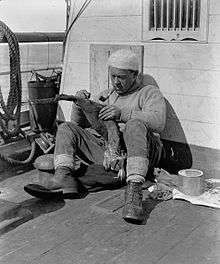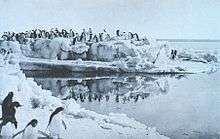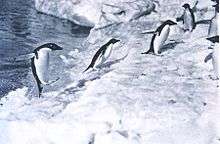George Murray Levick

George Murray Levick (1876–1956) was a British Antarctic explorer, naval surgeon and founder of the Public Schools Exploring Society (now the British Exploring Society).
Early life
Levick was born in Newcastle upon Tyne, the son of civil engineer George Levick and Jeannie Sowerby. His elder sister was the sculptor Ruby Levick. He studied medicine at St Bartholomew's Hospital and was commissioned in the Royal Navy in 1902.[1] He was secretary of the Royal Navy Rugby Union at its founding in 1907.
Terra Nova Expedition


He was given leave of absence to accompany Robert Falcon Scott as surgeon and zoologist on his Terra Nova Expedition. Levick photographed extensively throughout the expedition. Part of the Northern Party, Levick spent the austral summer of 1911–1912 at Cape Adare in the midst of an Adélie penguin rookery. As of June 2012, this has been the only study of the Cape Adare rookery, the largest Adélie penguin colony in the world, performed and he has been the only one to spend an entire breeding cycle there.[2] His observations of the courting, mating, and chick-rearing behaviours of these birds are recorded in his book Antarctic Penguins.[3] His notes about the penguins' sexual habits, which included sexual coercion, sex among males and sex with dead females, were deemed too indecent for publication at the time; So he wrote them in Greek so that only an educated gentleman would be able to read them. They were rediscovered and published in the journal Polar Record in 2012.[4] The discovery significantly illuminates the behaviour of a species that is an indicator of climate change.[4]
Prevented by pack ice from embarking on the Terra Nova in February 1912, Levick and the other five members of the party (Victor Campbell, Raymond Priestley, George Abbott, Harry Dickason, and Frank Browning) were forced to overwinter on Inexpressible Island in a cramped ice cave. Apsley Cherry-Garrard described the difficulties endured by the party in the winter of 1912:[5]
| “ | They ate blubber, cooked with blubber, had blubber lamps. Their clothes and gear were soaked with blubber, and the soot blackened them, their sleeping-bags, cookers, walls and roof, choked their throats and inflamed their eyes. Blubbery clothes are cold, and theirs were soon so torn as to afford little protection against the wind, and so stiff with blubber that they would stand up by themselves, in spite of frequent scrapings with knives and rubbings with penguin skins, and always there were underfoot the great granite boulders which made walking difficult even in daylight and calm weather. As Levick said, "the road to hell might be paved with good intentions, but it seemed probable that hell itself would be paved something after the style of Inexpressible Island." | ” |
On his return, Levick served in the Grand Fleet and at Gallipoli on board HMS Bacchante in the First World War. He was specially promoted in 1915 to the rank of fleet surgeon for his services with the Antarctic Expedition. He married Edith Audrey Mayson Beeton, a granddaughter of Isabella Beeton, on 16 November 1918.
After his retirement from the Royal Navy he pioneered the training of blind people in physiotherapy against much opposition. In 1932, he founded the Public Schools Exploring Society, which took groups of schoolboys to Scandinavia and Canada, and remained its President until his death in June 1956.
Second World War
In 1940, he returned to the Royal Navy, at the age of 64, to take up a position, as a specialist in guerilla warfare, at the Commando Special Training Centre at Lochailort, on the west coast of Scotland. He taught fitness, diet and survival techniques, many of which were published in his 1944 training manual Hardening of Commando Troops for Warfare.
He was one of the consultants for Operation Tracer; in the event that Gibraltar was taken by the Axis powers, a small party was to be sealed into a secret chamber in the Rock of Gibraltar to report enemy movements.
Death
At the time of his death, Major D. Glyn Owen, Chairman of the British Exploring Society wrote:[6]
| “ | A truly great Englishman has passed from our midst, but the memory of his nobleness of character and our pride in his achievements cannot pass from us. Having been on Scott's last Antarctic Expedition, Murray Levick was later to resolve that exploring facilities for youth should be created under as rigorous conditions as could be made available. With his usual untiring energy and purposefulness he turned this concept into reality when he founded the Public Schools Exploring Society in 1932, later to become the British Schools Exploring Society, drawing schoolboys of between 16 and 18½ years to partake in annual expeditions abroad into wild and trackless country. | ” |
Discovery of Levick's notebook
In 2013 Levick's notebook was found by a member of the Antarctic Heritage Trust. The notebook is part of the official record of Captain Scott's last expedition. It was found outside Scott's 1911 Cape Evans base. The notebook contains Levick's pencil notes detailing the date, subjects and exposure details for the photographs he took while at Cape Adare. After conservation it was returned to Antarctica.[7]
References
- ↑ London Gazette Publication date:28 November 1902 Issue: 27499 Page:8256
- ↑ "Shock at sexually 'depraved' penguins led to 100-year censorship". The Week. 10 June 2012.
- ↑ Levick, G. Murray (1914). Antarctic Penguins: a study of their social habits. New York: McBride Nast and Company.
- 1 2 McKie, Robin (9 June 2012). "'Sexual depravity' of penguins that Antarctic scientist dared not reveal". Guardian.co.uk.
- ↑ Cherry-Garrard, Apsley (1922). The Worst Journey in the World. London: Constable and Company.
- ↑ British Schools Exploring Society Annual Report, 1956.
- ↑ "Restored notebook goes home" Radio NZ Shannon Gillies 21 October 2014
Further reading
- Hooper, Meredith (2010). The Longest Winter: Scott's Other Heroes. London: John Murray. ISBN 9780719595806